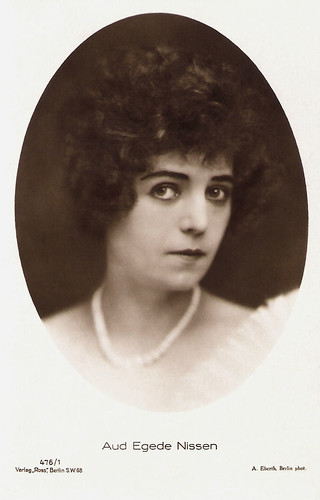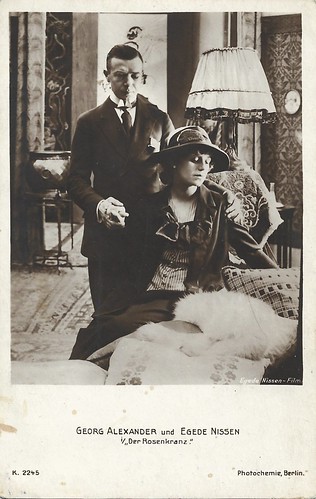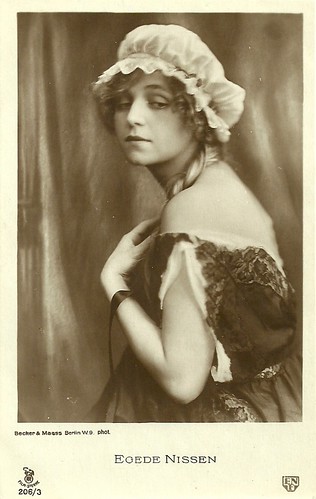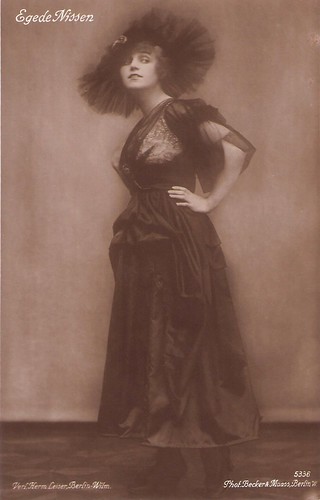
German postcard by Ross Verlag, no. 476/1, 1919-1924. Photo: A. Eberth, Berlin.

German postcard by Rotophot in the Film-Sterne series, no. 553/2. Photo: ENF (Egede-Nissen-Film). Aud Egede Nissen and Georg Alexander in the German silent film Die lachende Seele/The Laughing Soul (Georg Alexander, 1919).

German postcard by Ross Verlag, Berlin, no. 472/1, 1919-1924. Photo: Rembrandt Phot. / Union Film. Aud Egede Nissen as Jane Seymour in Anna Boleyn (Ernst Lubitsch, 1920).

German postcard by Ross Verlag, Berlin, no. 642/2, 1919-1924. Photo: Union Film. Jenny Hasselqvist and Aud Egede Nissen Sumurun (Ernst Lubitsch, 1920). Collection: Didier Hanson.

German collectors card by Ross Verlag in the series Vom Werden deutscher Filmkunst - Der Stumme Film, picture no. 103, group 43. Photo: Stern-Film. Eugen Klöpfer and Aud Egede Nissen in Die Strasse/The Street (Karl Grune, 1923).

Vintage postcard. Photo: Mon. Cawa-Film. Aud Egede Nissen and Paul Richter in Pietro der Korsar/Peter the Pirate (Arthur Robison, 1925).
The first female detective
Aud Egede Nissen, aka Aud Richter, was born in Bergen, Norway, in 1893. She was the daughter of Norwegian politician Adam Egede-Nissen. Her four younger sisters, including Gerd en Ada, and two younger brothers would become actors as well.
She started her film career in the Danish film Scenens børn/Children of the Stage; or, When Love Speaks (Bjørn Bjørnson, 1913). This film is now believed to be lost. After four films in Denmark, mostly shorts, she moved to Germany in 1914 and debuted there with the Dania-Film production Um ein Weib/Because of a Woman (Carl Schönfeld, 1914).
During the First World War, Nissen had an enormously productive career, changing from one company to another: from Nation Film and the direction of Alfred Halm to Literaria Film with Georg Jacoby directing, from Luna Film with Fred Sauer (who also directed her for Salden Film) to Greenbaum Film with Max Mack. She played a.o. in the serial Homunculus (Otto Rippert, 1916) with Theodor Loos.
In 1916/1917 she founded her own production company where her husband Georg Alexander directed her in films with herself in the lead. She appeared in more than one film per month (!), including Ich heirate meine Puppe/I Married My Doll (1917), and Das Geheimnis der Briefmarke/The Secret of the Stamp (1917). Very popular was the Ada-van-Ehlers serial. Ada van Ehlers impersonated the first female detective.
Slowly, Egede Nissen became more producer than an actress in 1917-1918, though she also continued to act in her own films as well. Nissen’s last own production within this constant and long production line probably was 100.000 Dollars (1919), as always directed by Georg Alexander, though still in 1921 the film Die Idee des Dr. Pax was released, which was a Nissen production as well.

With Georg Alexander. German postcard by Verlag Hermann Leiser, Berlin, no. 5074. Photo: Atelier B.J.G.

German postcard by Photochemie, no. K. 2245. Photo: Egede Nissen-Film. Georg Alexander and Aud Egede Nissen in the German silent melodrama Der Rosenkranz/The Rosary (Georg Alexander, 1918).

German postcard by Rotophot in the Film-Sterne series, no. 553/2. Photo: ENF (Egede-Nissen-Film). Aud Egede Nissen and Max Ruhbeck in Die lachende Seele/The Laughing Soul (Georg Alexander, 1919).

German postcard by Rotophot in the Film-Sterne series, no. 553/6. Photo: ENF (Egede-Nissen-Film). Aud Egede Nissen in Die lachende Seele/The Laughing Soul (Georg Alexander, 1919).

German postcard by Ross Verlag, Berlin, no. 1024/5, 1927-1928. Photo: Ufa. Aud Egede Nissen and Paul Richter in Pietro der Korsar/Peter the Pirate (Arthur Robison, 1925).

German postcard by Ross Verlag, Berlin, no. 26/1. Photo: Ufa. Aud Egede Nissen and Rudolf Klein-Rogge in Pietro der Korsar/Peter the Pirate (Arthur Robison, 1925).

German postcard by Ross Verlag, Berlin, no. 26/5, 1927-1928. Photo: Ufa. Aud Egede Nissen and Paul Richter in Pietro der Korsar/Peter the Pirate (Arthur Robison, 1925).
Lubitsch, Lang and Murnau
Around 1920. Aud Egede Nissen shifted to performing in major productions. She was Sumurun’s (Pola Negri) servant Haidee in Ernst Lubitsch’s murderous exotic tale Sumurun (1920), the daughter of a merchant freed from Chinese bandits by a reporter in Schiffen und Menschen/Ships and People (Carl Boese, 1920), a female artist in the third sequel to Die Lieblingsfrau der Maharadscha/The Favorite Wife of the Maharadja (Max Mack, 1920), Jane Seymour in Lubitsch’ epic Anna Boleyn (Ernst Lubitsch, 1920), and the dancer Cara Carozza, accomplice to evil hypnotist Mabuse, in Fritz Lang’s thriller Dr. Mabuse, der Spieler/Dr. Mabuse: The Gambler (1921/1922).
In 1922 Nissen was Melanie Lubota, the sister of the main character (Alfred Abel) in F.W. Murnau's Phantom/The Phantom. In 1923 she was the prostitute in the expressionist drama Die Strasse/The Street (Karl Grune, 1923). The story is about a man, who leaves his wife and humdrum life to seek the excitement of a Parisian street. He spends most of the story chasing after a prostitute thief, which eventually leads him to prison and despair. He then returns to his previous life. In Carlos un Elisabeth (Richard Oswald, 1923), Nissen played Princess Eboli opposite Conrad Veidt.
Later she had the female leads in three realist films by Gerhard Lamprecht: Menschen untereinander (Gerhard Lamprecht, 1925), Die Verrufenen (Gerhard Lamprecht, 1925), and Schwester Veronika (Gerhard Lamprecht, 1925). Other films were the Dutch-German coproduction Droomkoninkje/Die vom Schicksal verfolgten/Little Dream King (Henk Kleinman, 1926), and Die Villa im Tiergarten/The Villa in the Zoo (Franz Osten, 1926).
In such films as Pietro, der Korsar/Pietro the Cossack (Artur Robison, 1925), and Der König der Mittelsturmer/King Of The Centre-forward (1927) she appeared opposite her second husband, Paul Richter. The latter can be considered the first real German soccer feature.
In her last silent film, Die Frau im Talar/The Woman in the Robe (Adolf Trotz, 1929), clearly designed for her, Aud Egede Nissen played a female prosecutor in a Norwegian (!) harbour town, who must judge the man she loves (Paul Richter) for a fraud committed by her own father out of despair.

German postcard by Rotophot in the Film Sterne series, no. 206/1. Photo: Becker & Maas / Egede-Nissen-Film (ENF).

German postcard by Rotophot in the Film-Sterne series, no. 206/2. Photo: Becker & Maass, Berlin / ENF.

German postcard by Rotophot in the Film-Sterne series, no. 206/3. Photo: Becker & Maass, Berlin / ENF.

German postcard by NPG, no. 436. Photo: Alex Binder, Berlin.

German postcard by Photochemie, Berlin, no. K. 173. Photo: Alex Binder, Berlin.

German postcard by Photochemie, Berlin, no K. 216. Photo: Alex Binder, Berlin.
Back to Norway
Aud Egede Nissen played roles in the German sound film Zwischen Nacht und Morgen/Between Night and Dawn (Gerhard Lamprecht, 1931) opposite Oscar Homolka, and the Danish film Eskimo (Georg Schnéevoigt, 1930), starring Mona Mårtenson. She broke up with Richter and went back to Norway in 1931.
In Norway, her experience was appreciated and she became the production manager for two films: En glad gutt/A Happy Boy (John W. Brunius, 1932) and Syndere i sommersol/Sinners in summer sun (Einar Sissener, 1934). She also played small parts in two films during the war years, Hansen og Hansen/Hansen and Hansen (Alfred Maurstad, 1941) and the romantic drama Trysil-Knut (Rasmus Breistein, 1942), starring Alfred Maurstad.
During the 1930s Nissen debuted on the Norwegian stage and played a large number of roles in 1934-1935, including Hermione in 'The Winter's Tale' (1934) and Gertrud in 'Hamlet' (1935). In 1939 she debuted as a theatre director with the play 'Ansikt til ansikt' (Face to Face). In particular, between 1955 and 1962 she directed many plays.
Aud Egede Nissen died in Oslo, Norway, in 1974. From 1915 to 1924, she was married to actor-director Georg Alexander. She then married actor Paul Richter whom she divorced in 1931. Her son by Georg Alexander, named after his stepfather Georg Richter, also became an actor and producer. Since 1940 she was married to Dag Havrevold.

Austrian postcard by Iris Verlag, no. 830. Photo: National Film / Distr. Mondial A.G. Aud Egede Nissen in Schwester Veronica/Sister Veronica (Gerhard Lamprecht, 1927).

German postcard by Verl. Herm. Leiser, Berlin-Wilm, no. 5336. Photo: Becker & Maas, Berlin-W.

German postcard by Ross Verlag, Berlin, no. 335/3, 1919-1924. Photo: Curt Meyer, Berlin / Adler-Film.

German postcard by Ross Verlag, Berlin, no. 385/2, 1919-1924. Photo: Curt Mayer, Wilmendorf / Adler-Film.

German postcard by Ross Verlag, Berlin, no. 1144/1, 1927-1928. Photo: Karl Schenker, Berlin.

German postcard by Ross Verlag, Berlin, no. 3534/1, 1928-1929. Photo: Atelier Balázs, Berlin.

German postcard by Photochemie, no. K. 1660. Photo: Ernst Schneider.
Aud Egede Nissen in the silent Norwegian-German crime film Bergenstoget plyndret inatt/Schneeschuhbanditen (Uwe Jenns Krafft, 1928) with Paul Richter. Source: Norskfilminstitutt (YouTube).
Sources: Thomas Staedeli (Cyranos), Filmportal.de (German), Wikipedia, and IMDb.
Next week on EFSP a post dedicated to Aud's lesser-known sisters, Gerd Egede-Nissen and Ada Nissen a.k.a. Ada van Ehlers.
No comments:
Post a Comment